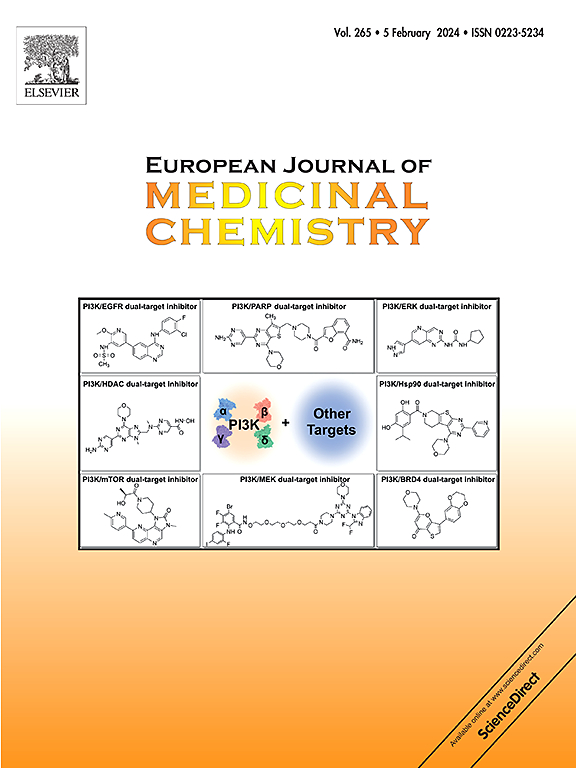开发新的抗生素:通过晶体学片段筛选发现的铜绿假单胞菌 FabF 配体,然后进行命中扩展
IF 6
2区 医学
Q1 CHEMISTRY, MEDICINAL
引用次数: 0
摘要
迫切需要新的抗生素。脂肪酸合成II途径中催化限速缩合反应的FabF(3-氧酰基-[酰基-载体蛋白]合成酶2)是一个有吸引力的靶标。已知的FabF抑制剂很少,大多数来自天然产物。为了进一步探索FabF配体的化学空间,我们对P. aeruginosa FabF的中间状态模拟变体(PaFabF C164Q)进行了x射线晶体学的片段筛选。这一筛选产生了48个,其中16个结合在或接近丙二酰辅酶a或脂肪酸结合位点或相邻二聚体界面。近距离研究的片段在结合试验中都没有活性,但从有效的FabF抑制剂中提取的片段也是如此。对于命中优化,我们将重点放在靠近FabF催化残基结合的两个片段上。在优化过程中采用了不同的策略:探索商业上可用的类似物,片段合并,组合按需空间的虚拟筛选,以及设计和内部合成类似物。总共探索了90多种命中化合物的类似物,其中10种共晶结构可以确定。通过手工结构设计发现了最有效的配体,其结合亲和力为65 μM。该数据包为开发更有效和多样化的FabF抑制剂奠定了坚实的基础。本文章由计算机程序翻译,如有差异,请以英文原文为准。


Towards new antibiotics: P. aeruginosa FabF ligands discovered by crystallographic fragment screening followed by hit expansion
There is an urgent need for new antibiotics. FabF (3-oxoacyl-[acyl-carrier-protein] synthase 2), which catalyses the rate limiting condensation reaction in the fatty acid synthesis II pathway, is an attractive target. Very few inhibitors of FabF are known and most are derived from natural products. In an effort to further explore the chemical space of FabF ligands, we have carried out fragment screening by X-ray crystallography against an intermediated state-mimicking variant of P. aeruginosa FabF (PaFabF C164Q). This screen has resulted in 48 hits out of which 16 bind in or close to the malonyl-CoA or fatty acid binding site or an adjacent dimer interface. None of the closer investigated fragments were active in a binding assay, but the same was the case for fragments derived from a potent FabF inhibitor. For hit optimization, we focused on the two fragments binding close to the catalytic residues of FabF. Different strategies were followed in the optimization process: exploration of commercially available analogues, fragment merging, virtual screening of a combinatorial make-on-demand space, and design and in-house synthesis of analogues. In total, more than 90 analogues of the hit compounds were explored, and for 10 of those co-crystal structures could be determined. The most potent ligand was discovered using manual structure-based design and has a binding affinity of 65 μM. This data package forms a strong foundation for the development of more potent and diverse FabF inhibitors.
求助全文
通过发布文献求助,成功后即可免费获取论文全文。
去求助
来源期刊
CiteScore
11.70
自引率
9.00%
发文量
863
审稿时长
29 days
期刊介绍:
The European Journal of Medicinal Chemistry is a global journal that publishes studies on all aspects of medicinal chemistry. It provides a medium for publication of original papers and also welcomes critical review papers.
A typical paper would report on the organic synthesis, characterization and pharmacological evaluation of compounds. Other topics of interest are drug design, QSAR, molecular modeling, drug-receptor interactions, molecular aspects of drug metabolism, prodrug synthesis and drug targeting. The journal expects manuscripts to present the rational for a study, provide insight into the design of compounds or understanding of mechanism, or clarify the targets.

 求助内容:
求助内容: 应助结果提醒方式:
应助结果提醒方式:


